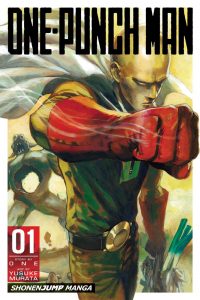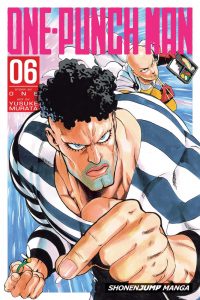By ONE and Yusuke Murata | Published by VIZ Media
 My name is Saitama. I am a hero. My hobby is heroic exploits. I got too strong. And that makes me sad. I can defeat any enemy with one blow. I lost my hair. And I lost all feeling. I want to feel the rush of battle. I would like to meet an incredibly strong enemy. And I would like to defeat it with one blow. That’s because I am One-Punch Man.
My name is Saitama. I am a hero. My hobby is heroic exploits. I got too strong. And that makes me sad. I can defeat any enemy with one blow. I lost my hair. And I lost all feeling. I want to feel the rush of battle. I would like to meet an incredibly strong enemy. And I would like to defeat it with one blow. That’s because I am One-Punch Man.
One-Punch Man is much loved on Manga Bookshelf, and now I can finally be included in the group singing its praises!
Three years ago, depressed after botching a job interview, Saitama encountered a crab monster. Defeating it was much more enjoyable than looking for a job, so he decided to become a hero for fun. Since then, he’s been vanquishing the monsters that plague his city but not getting any credit for it. (Who is receiving the credit is a later plot point.) Overwhelming strength has become boring, but when he meets Genos, a cyborg driven by revenge, he gains a disciple and also learns about the Hero Association, which employs heroes of various classes and dispatches them as needed to counter various monstrous threats, which have been on the rise.
 The balancing act ONE and Murata achieve here is impressive. On the one hand, One-Punch Man is gloriously silly. Heroes and foes alike are apt to be ludicrous, and some of the former have terrific names like Tank Top Vegetarian or Spring Mustachio (although I actually think he’s pretty cool). On the other hand, there is a lot of excellent shounen manga storytelling going on. The way Saitama lives his life without criticism for others makes me think he’d get along well with One Piece‘s Luffy, and the devotion his pupil Genos shows for him means they can always rely on each other. Too, after Saitama joins the Hero Association, we get regular updates on how his rank is improving, and this puts him in contact with even more heroes, some of whom are inept, some of whom are capable, and one of whom might actually be an enemy. He doesn’t seek glory, so many are unaware of his true strength, but I assume that eventually he will attain the rank he deserves (currently, due to poor performance on the written test, he’s far below Genos).
The balancing act ONE and Murata achieve here is impressive. On the one hand, One-Punch Man is gloriously silly. Heroes and foes alike are apt to be ludicrous, and some of the former have terrific names like Tank Top Vegetarian or Spring Mustachio (although I actually think he’s pretty cool). On the other hand, there is a lot of excellent shounen manga storytelling going on. The way Saitama lives his life without criticism for others makes me think he’d get along well with One Piece‘s Luffy, and the devotion his pupil Genos shows for him means they can always rely on each other. Too, after Saitama joins the Hero Association, we get regular updates on how his rank is improving, and this puts him in contact with even more heroes, some of whom are inept, some of whom are capable, and one of whom might actually be an enemy. He doesn’t seek glory, so many are unaware of his true strength, but I assume that eventually he will attain the rank he deserves (currently, due to poor performance on the written test, he’s far below Genos).
Although I don’t ordinarily comment much on art, Murata employs quite a few innovative tricks that make reading One-Punch Man different than the average manga. For one thing, Saitama is almost always drawn with a simple, bland expression, making the few times he looks determined or actually heroic a nice treat. Plus, I love how we get back-to-back two-page spreads from time to time. Some of these depict combatants exchanging blows, first with one landing a punch and then the other, but he also uses them to zoom in from, say, an attack that is heading Saitama’s way down to his fist that is about to get serious. It’s a fun way of depicting the action while continuing to incorporate humor. (Oh, incidentally, Saitama’s special attack, almost never required, is awesomely called “Consecutive Normal Punches.” We’ve only seen the finishing move—Serious Punch!!!—once so far.)
 As of volume eleven, there are several plotlines in play. Monsters are appearing everywhere, and appear to be organizing. Is this tied in with the prediction of an extinction-level event within the next six months? What about that hint of a possible traitor that was dropped a few volumes back? While a rogue martial artist named Garo is hunting heroes, Saitama is off at a martial arts tournament to learn more how to defeat Garo (not knowing that he totally already did) and seems destined to face off against another strong fighter who is desperate for a challenge. I admire how this story has widened in scope in a natural way, without compromising the balance of narrative and humor. It could conceivably go on for a very long time, and I deeply hope it does.
As of volume eleven, there are several plotlines in play. Monsters are appearing everywhere, and appear to be organizing. Is this tied in with the prediction of an extinction-level event within the next six months? What about that hint of a possible traitor that was dropped a few volumes back? While a rogue martial artist named Garo is hunting heroes, Saitama is off at a martial arts tournament to learn more how to defeat Garo (not knowing that he totally already did) and seems destined to face off against another strong fighter who is desperate for a challenge. I admire how this story has widened in scope in a natural way, without compromising the balance of narrative and humor. It could conceivably go on for a very long time, and I deeply hope it does.
One-Punch Man is ongoing in Japan, where it is up to twelve volumes. Currently, VIZ has released ten volumes in print and eleven digitally.
Review copies provided by the publisher.




Speak Your Mind